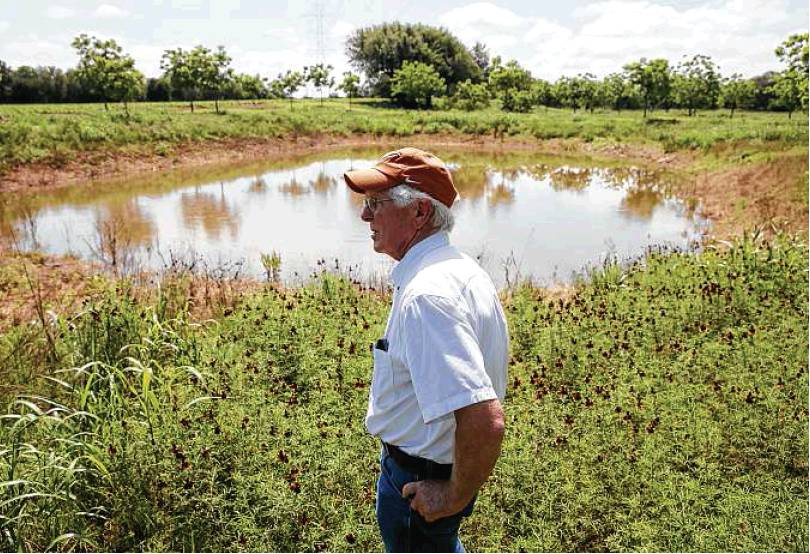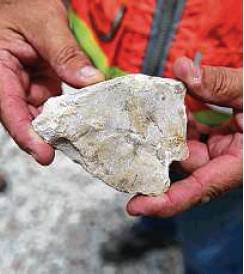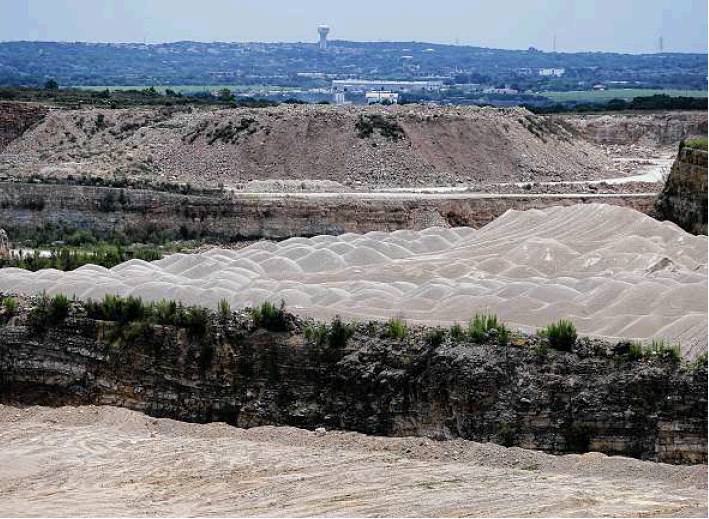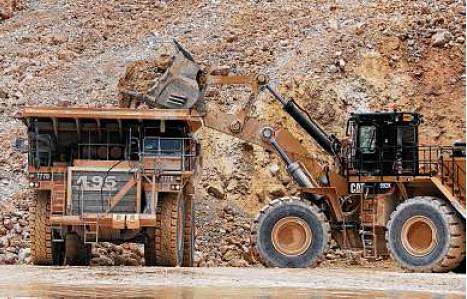SECOND OF TWO PARTS
Residents struggle to coexist with quarries
Home-shaking blasts, constant noise take a toll on neighbors
By Brian Chasnoff STAFF WRITER
COMAL COUNTY — Growing up in the Texas Hill Country, Mark Friesenhahn often would run barefoot through the countryside with his younger brother — but only if their father, “a 150-pound, mean little banty rooster German, full of the culture and work ethic,” hadn’t assigned them a task on the family farm.
Occasionally, the boys would hear a siren warning of an imminent blast at the Servtex Quarry Plant 3 miles away.
“The blast would occur, we’d feel the rumble, and we went back to what we were doing. It was no big deal,” recalled Friesenhahn, now 71.
Friesenhahn spent more than four decades at ExxonMobil in Houston as a technical adviser on oil and gas operations. He moved back to his boyhood haunts in 2010 to grow soft-shell pecans on the same land settled by his German ancestors in 1854.
Today, Friesenhahn’s inherited slice of the Hill Country is surrounded by “Quarry Row,” a cluster of 11 rock mining operations that stretches for nearly 30 miles along Interstate 35, from the Servtex quarry in Garden Ridge to the Colorado Materials Hunter Plant 2 north of New Braunfels.
The proliferation of quarries has altered more than the landscape. It’s changed Friesenhahn’s worldview.
He’s a conservative Republican who made his fortune in the oil and gas industry. He’s long been a believer in free markets, low taxes and light regulation.
But living in quarry country has turned him into a leading voice for tighter controls on mining. He co-founded Texans for Responsible Aggregate Mining and regularly testifies at the state Capitol to demand more rigorous oversight of the industry.
‘Looking for ... equity’
When Friesenhahn and his brother were running through the fields in the 1960s, Comal County had 20,000 residents. Today, it has more than 161,000.
“We’ve massively populated this area, and these (quarries) are moving in right on top of this growth because that’s where their resource is,” Friesenhahn said.
As he can attest, that combination comes at a cost.
One morning in June 2020, a farmhand called Friesenhahn to tell him his orchard had been flooded with thick, sediment-laden water — “think cream-colored yogurt that is as gooey as you could possibly imagine.”
The source: the neighboring AC Tejas Quarry, operated by Anderson Columbia Co. Inc.
Water used to wash rocks was being treated in a sediment pond, and it had overflowed. About 500,000 gallons of water and clay sediment had flowed under a railroad trestle and onto Friesenhahn’s property, covering 15 acres of his orchard to a depth of a foot and a half.
He complained to the Texas Commission on Environmental Quality, triggering an investigation. The agency found the quarry was pumping more water into the pond than it could remove, too much sediment had accumulated and the pond suffered from a “lack of maintenance.”
The TCEQ opted not to take samples of the gunk, a decision that bothered the former oilman because it “could have been a toxic material.”
The quarry paid for lab tests, which confirmed that the waste was “pretty benign,” Friesenhahn said.
Anderson Columbia, which opened the quarry in 2016, also offered to clean up the mess. Friesenhahn said he and his farmhand did it themselves. It took four months and cost about $5,000.
“I didn’t want these damn operators from the mine digging around in my orchard,” Friesenhahn said. “We scraped all this. We piled it up. They came and hauled it off.”
Anderson Columbia has offered to cover his losses.
The TCEQ required the company to document how it would prevent more discharges from the site. The state agency lists the quarry’s violation as “resolved.”
Friesenhahn worries that another spill could damage his orchard again.
“If they would have had comprehensive regulation on planning, design, construction and operation of their mining operation, none of this would have happened,” he said.
Anderson Columbia did not respond to requests for comment for this article.
Recalling his time at ExxonMobil, Friesenhahn said: “We fought hard for minimal regulations. And what’s happened here, the pendulum has swung so far with our state leadership toward commercial development that they’ve lost track of the health and safety of the public and Texas residents. What we’re looking for is equity, to move this thing back to the middle.”
‘Is it an earthquake?’
A few miles from Friesenhahn’s farm, at the southern tip of Quarry Row, lies the nearly century-old Servtex plant in Garden Ridge, a city northeast of San Antonio that grew up around the quarry.
Garden Ridge formed a Quarry Commission in 2000 to address concerns about the 700-acre plant, which is operated by Lehigh Hanson Materials South LLC. It’s the same quarry whose siren Friesenhahn heard as a boy.
The commission, whose seven members are appointed by the city council, monitors blasts at the site by local ordinance, a layer of oversight not possible in unincorporated areas.
Every two months, Hanson representatives stand before the commission to present blast data, reassuring residents, for instance, that peak particle velocities — the speed of shock waves caused by controlled blasts, which occur about three times a week — stay within limits set by the U.S. Bureau of Mines.
Garden Ridge operates a website where residents can log complaints about Hanson. The complaints are read aloud at commission meetings. Lehigh Hanson representatives reach out to residents to discuss problems.
“We have an outstanding working relationship with Hanson quarry,” Garden Ridge Mayor Robb Erickson said. “We do get a little bit of revenue from them, which helps us as a city. So that’s one way that we help keep our taxes relatively low.”
Hanson Aggregates, a division of Lehigh Hanson, paid the city more in property taxes than any other entity last year, and it accounted for 7.5 percent of Garden Ridge’s total taxable property value, according to the city’s 2020 audit. The operation employs about 90 people.
“We are happy to be their neighbors,” Erickson said, “and I think the feeling is mutual.”
Not for everyone. Residents complain that blasts from the plant shake and even damage their homes.
“It scares the mess out of you,” said Johnell Holly. “You’re wondering, ‘What is this? Is it an earthquake? Is it a bomb? Did something crash?’ ”
Holly, 73, a retired electrical engineer, moved into the upscale Trophy Oaks subdivision in 2016, onto a lot that borders the quarry. The commission’s members elected him chairman this year.
“The commission is useful,” Holly said. “How useful is it? We can’t tell them to quit. But we can be a voice of the people and let them know what the concerns are.”
Janet Hayslip, 60, a senior executive assistant, moved to Garden Ridge in 2015. She regularly logs complaints about the quarry with the city’s commission.
“I’m originally from California, and when I first felt a blast, I thought, ‘What the heck is going on?’ ” Hayslip said. “I compared it to the feeling of an earthquake, and I was just kind of shocked to have an earthquake feeling when I moved away from all that.
“We moved here because it is a bedroom community, and you’re not dealing with business activity and commercial activity,” she added.
‘Not in my backyard’
On a recent morning, Hanson allowed a reporter and photographer to tour the site — a man-made canyon rimmed with 70-foot rock walls and stretching for miles in all directions.
That day, workers used 13,000 pounds of explosives to break loose 20,000 tons of rock, sending plumes of dust into the air. Caterpillar earthmovers scooped up loose rocks and hauled them across a barren moonscape to the quarry’s labyrinthine network of crushing machines.
Tanker trucks sprayed the dusty road with water.
“If you over-water the road, you make a muddy mess,” said Pat Pie-ton, the plant manager. “If you under-water the road, it doesn’t control the dust. This is the perfect blend. It’s not kicking up, sticking to everything.”
Pieton said the biggest issue facing the quarry is an attitude he summed up as “NIMBY — not in my backyard.”
“That’s what we all deal with,” Pieton said. He noted that the quarry was there long before the city of Garden Ridge.
“This place started 85 years ago in ’36. ’72 is when Garden Ridge came. But you know what? ‘There’s a damn quarry next to us.’ We’re also the largest taxpayer for Garden Ridge. The largest job supplier, if they want it. So it’s in their best interest.”
The quarry is a “24/7 operation,” Pieton added. “This whole industry is more of a meat grinder, if you will. A lot of hours are put in by a lot of people.”
Armando Diaz, another member of the city’s commission, said the constant grind at the quarry can wear residents down.
“It just seems that the regulations don’t keep up with the impacts on the homeowners,” Diaz said. “It’s not just the blasting. Now you can always hear the quarry noise — the conveyor belts, the crushers, the movers, all the machinery that’s at the quarry. And especially at night, when you would expect peace and quiet.”
Up the road, Friesenhahn hopes lawmakers will listen to the concerns of residents struggling to coexist with quarries.
“I’m trying to help figure out ways to preserve our beautiful Central Texas Hill Country,” he said, “so that people will want to come here to visit, our kids will want to come back, our grandkids will want to come back.”




